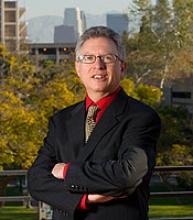Blog
Stop the VideoResearch Projects

A Systems Perspective Would Improve Transit Performance
Posted 2/4/2016 by METRANS

Looking at the graph (from the LA Times Jan. 27 article, shown above), the data are from 1985 to the present, showing a substantial decline through the early 1990a, when LA Metro and their predecessor agencies shifted funds from a bus system to the new rail system, and then increases which, with some ups and downs, have returned almost to the ridership levels of 30 years ago. That is not a ringing endorsement of Metro’s transit policies, but it is also not a new story. This is a long-term issue.
Let me suggest how not to interpret this. The wrong interpretation is to conclude that the rail investment was flawed, the region should have never built trains, and that if only we could go back to the glorious days of buses, all would be well in the City of Angels (at least in terms of transit.) Simple modal dichotomies – e.g. "steel wheels bad, rubber tires good" – are uninteresting in an age when travel is seamlessly multi-modal, 25 percent of all trips in the region are on foot, and technology allows an easy mixing of on-demand ride services, parking, transit, and (quite some time in the future) autonomous vehicles. In an increasingly dense city, with a transportation system transformed from an "ownership" to a "sharing" economy, there will be a role for backbone transportation services, including transit. What role should that take?
Let’s not let Metro off the hook too easily, though. Metro bears responsibility for a thirty year investment that, on net, has held ridership almost to 1985 levels. Transit is still primarily a lifeline for low-income persons who cannot afford vehicles. The decline in ridership in the 1980s reflects a lack of imagination, or an unwillingness to plan for the city’s most vulnerable and transit dependent populations. Fixed-route rail, in a city that must build up rather than out, has a role. But the fact that the region hardly even considered bus rapid transit until ten years ago, and that BRT lines lag behind what has been deployed in other cities, is a shame. We should take the data as a sign to continue to think multi-modally, but more carefully and realistically so.
There are two reasons why despite large investments in mass transportation, transit ridership is flat (on net) over the past thirty years. (1) Los Angeles failed to build a transit system for the people who ride it. I’m all for extending transit into middle and upper income neighborhoods when and where that makes sense, but transit is an equity tool, and that has been overlooked. South Los Angeles. East Los Angeles. Where are their trains? (Yes, they have a few, but those areas are often, by measures of demand, transit-underserved.) (2) The reason why transit did not continue to serve its primary market is, in decent part, financing. Transportation finance is in a crisis. Los Angeles County has papered over the problem through half-cent sales tax increases. That was the only funding mechanism available, and I support the proposed extension of the Measure R sales tax increment.
But let’s not kid ourselves. Sales taxes are, if anything, an exercise in the politically practical and far from an effective transportation finance tool. We should be exploring mileage fees (ideally weighted based on fuel consumption or pollutants emitted from the vehicle) and congestion pricing. Seventy-five percent of all transportation funds spent in the greater L.A. area are from local (sub-state) tax sources. We need to aggressively move toward a transportation system that finances our investments fairly, by charging persons for the pollution and congestion that they create. While we are at it, let’s be sure to tax the new rideshare services, Uber, Lyft, and the like, based on mileage fees, with higher taxes for rideshare services that occur during congested time periods in congested locations. Use the revenues from well-crafted mileage fees to maintain and, as needed, expand our highways, fill potholes in the roads, expand bus service, and complete our rail system.
More broadly, to address the issue of declining ridership, Metro needs to think systematically. Metro does not just run a bus system. They are the transportation agency for the County of Los Angeles. Metro operates two high occupancy toll lanes, they are the county agency charged with highway planning and maintenance, and with a little foresight Metro can cooperate on parking management and fair share fees for ridesharing services. A systematic approach will do more to address transit ridership than any policy that focuses on transit alone.
Marlon Boarnet
Dr. Boarnet is a renowned authority on urban economics, urban growth patterns, transportation, and regional science. He is an expert in transportation and land use, and has served on the National Research Council committee that authored "Driving and the Built Environment." He has published extensively in leading journals such as Regional Science and Urban Economics, Environment and Behavior, Urban Studies, Journal of Urban Economics, Journal of Planning Education and Research, National Tax Journal, and Journal of the American Planning Association. He is also co-author of Travel by Design: The Influence of Urban Form on Travel (Oxford University Press, 2001).















